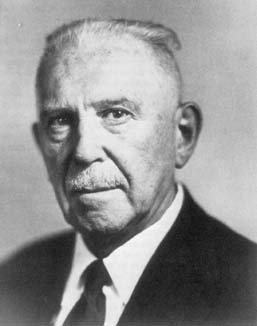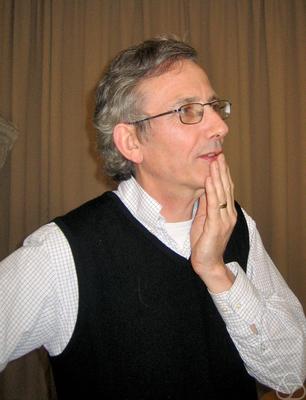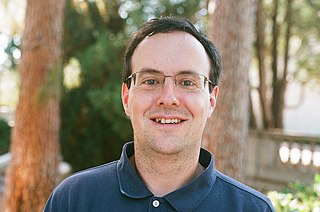In differential geometry, a subject of mathematics, a symplectic manifold is a smooth manifold, , equipped with a closed nondegenerate differential 2-form , called the symplectic form. The study of symplectic manifolds is called symplectic geometry or symplectic topology. Symplectic manifolds arise naturally in abstract formulations of classical mechanics and analytical mechanics as the cotangent bundles of manifolds. For example, in the Hamiltonian formulation of classical mechanics, which provides one of the major motivations for the field, the set of all possible configurations of a system is modeled as a manifold, and this manifold's cotangent bundle describes the phase space of the system.
In mathematics, complex geometry is the study of geometric structures and constructions arising out of, or described by, the complex numbers. In particular, complex geometry is concerned with the study of spaces such as complex manifolds and complex algebraic varieties, functions of several complex variables, and holomorphic constructions such as holomorphic vector bundles and coherent sheaves. Application of transcendental methods to algebraic geometry falls in this category, together with more geometric aspects of complex analysis.

In mathematics, the Hodge conjecture is a major unsolved problem in algebraic geometry and complex geometry that relates the algebraic topology of a non-singular complex algebraic variety to its subvarieties.

In algebraic geometry, a projective variety over an algebraically closed field k is a subset of some projective n-space over k that is the zero-locus of some finite family of homogeneous polynomials of n + 1 variables with coefficients in k, that generate a prime ideal, the defining ideal of the variety. Equivalently, an algebraic variety is projective if it can be embedded as a Zariski closed subvariety of .

Solomon Lefschetz was a Russian-born American mathematician who did fundamental work on algebraic topology, its applications to algebraic geometry, and the theory of non-linear ordinary differential equations.
In mathematics and especially differential geometry, a Kähler manifold is a manifold with three mutually compatible structures: a complex structure, a Riemannian structure, and a symplectic structure. The concept was first studied by Jan Arnoldus Schouten and David van Dantzig in 1930, and then introduced by Erich Kähler in 1933. The terminology has been fixed by André Weil. Kähler geometry refers to the study of Kähler manifolds, their geometry and topology, as well as the study of structures and constructions that can be performed on Kähler manifolds, such as the existence of special connections like Hermitian Yang–Mills connections, or special metrics such as Kähler–Einstein metrics.
In mathematics, Hodge theory, named after W. V. D. Hodge, is a method for studying the cohomology groups of a smooth manifold M using partial differential equations. The key observation is that, given a Riemannian metric on M, every cohomology class has a canonical representative, a differential form that vanishes under the Laplacian operator of the metric. Such forms are called harmonic.
In mathematics, the canonical bundle of a non-singular algebraic variety of dimension over a field is the line bundle , which is the nth exterior power of the cotangent bundle on .

Sir Simon Kirwan Donaldson is an English mathematician known for his work on the topology of smooth (differentiable) four-dimensional manifolds, Donaldson–Thomas theory, and his contributions to Kähler geometry. He is currently a permanent member of the Simons Center for Geometry and Physics at Stony Brook University in New York, and a Professor in Pure Mathematics at Imperial College London.

In algebraic geometry, a linear system of divisors is an algebraic generalization of the geometric notion of a family of curves; the dimension of the linear system corresponds to the number of parameters of the family.
In mathematics, the Hodge index theorem for an algebraic surface V determines the signature of the intersection pairing on the algebraic curves C on V. It says, roughly speaking, that the space spanned by such curves has a one-dimensional subspace on which it is positive definite, and decomposes as a direct sum of some such one-dimensional subspace, and a complementary subspace on which it is negative definite.
In mathematics, specifically in algebraic geometry and algebraic topology, the Lefschetz hyperplane theorem is a precise statement of certain relations between the shape of an algebraic variety and the shape of its subvarieties. More precisely, the theorem says that for a variety X embedded in projective space and a hyperplane section Y, the homology, cohomology, and homotopy groups of X determine those of Y. A result of this kind was first stated by Solomon Lefschetz for homology groups of complex algebraic varieties. Similar results have since been found for homotopy groups, in positive characteristic, and in other homology and cohomology theories.
In mathematics, a hyperplane section of a subset X of projective space Pn is the intersection of X with some hyperplane H. In other words, we look at the subset XH of those elements x of X that satisfy the single linear condition L = 0 defining H as a linear subspace. Here L or H can range over the dual projective space of non-zero linear forms in the homogeneous coordinates, up to scalar multiplication.
In mathematics, specifically in symplectic geometry, the symplectic sum is a geometric modification on symplectic manifolds, which glues two given manifolds into a single new one. It is a symplectic version of connected summation along a submanifold, often called a fiber sum.
In mathematics, the theorem of Bertini is an existence and genericity theorem for smooth connected hyperplane sections for smooth projective varieties over algebraically closed fields, introduced by Eugenio Bertini. This is the simplest and broadest of the "Bertini theorems" applying to a linear system of divisors; simplest because there is no restriction on the characteristic of the underlying field, while the extensions require characteristic 0.
In algebraic geometry, a branch of mathematics, the Lefschetz theorem on (1,1)-classes, named after Solomon Lefschetz, is a classical statement relating holomorphic line bundles on a compact Kähler manifold to classes in its integral cohomology. It is the only case of the Hodge conjecture which has been proved for all Kähler manifolds.
This is a glossary of properties and concepts in algebraic topology in mathematics.
Ivan Smith is a British mathematician who deals with symplectic manifolds and their interaction with algebraic geometry, low-dimensional topology, and dynamics. He is a professor at the University of Cambridge.

Denis Auroux is a French mathematician working in geometry and topology.







